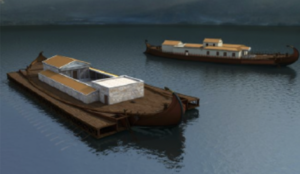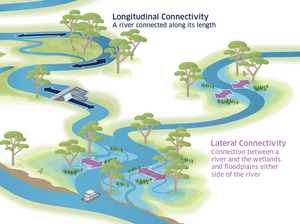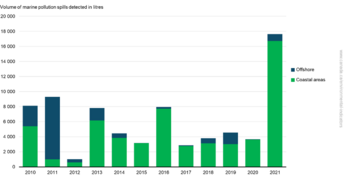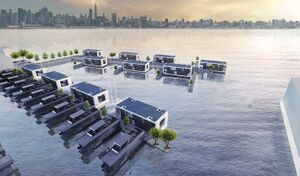Course:EOSC270/2023/Buoyant Living; Exploring Floating Infrastructures and Its Impact to the Environment

Background - Beginning of Floating Infrastructures

The first type of floating infrastructures to be created by the human-kind were houseboats, which is known to be the origin of floating homes. Houseboats were created in 200 B.C. by Philopator, the Macedonian King of Egypt. He called his houseboat "Thalamego'', and it was approximately 90 m in length and 17 m in height (Figure 1)[1]. The structure of this houseboat was created to fit the river’s depth and to combat the river's high waves. It had two decks that contained banquet halls, bedrooms, kitchens and other facilities. Although the Thalamegos may sound like the origin of a cruise ship, because it was to be a floating palace for the king, it would be more accurate to describe it as the beginning of floating houses.
The Romans also had their version of the Thalamegos called the Cubiculatae. It was a similar build but was shorter and had a wider build. These houseboats were often reused as cargo ships after serving their purpose as palace boats. The model closest to the modern floating houses was the Nemi Ships (Figure 2), created for the Roman imperator Caligula. Although Nemi ships were destroyed by the Senate of Rome when Caligula died, it's hypothesized that Nemi ships were very large. Some ships were recorded to be 68 m in length and 24 m in height, with a house-like structure on top of the boat. Unlike the Thalamegos, their bottoms were flat, meaning their purpose was to float in the quiet bodies of water, and were towed by other boats when needed to translocate[1]. These Nemi ships created for Caligula were decorative compared to the other two floating homes and contained luxury accommodations for hosting ceremonies. It was also recorded that Nemi Ships were anchored to stay in one location, reflecting the modern design of floating homes[1].
How does this impact marine ecosystems?
Direct Positive feedback

Providing habitat: Underwater structures may promote reef-like environments, offering additional surfaces for benthic organisms to colonize[3]. These habitats facilitate the growth of algae and shellfish, contributing significantly to marine ecosystems. Algae and shellfish play pivotal roles in water filtration, nutrient recycling, and providing sustenance and shelter for various marine species. The presence of such structures protects larvae, fostering an improved ecological balance within the marine environment[2].
Increasing biodiversity: Artificial structures may increase local biodiversity by providing habitats for various marine organisms and attracting higher trophic levels such as fish, turtles, and marine mammals. Furthermore, these structures serve as a refuge, offering protection from wave action, thereby creating stable habitats conducive to the proliferation of marine species.
Indirect Positive feedback

Exclusion of Shipping Traffic: Floating island structures can exclude shipping traffic from areas for extended periods, leading to potential improvements in air and water quality and benefiting marine flora and fauna. Although the results from several different study locations show lower dissolved oxygen concentrations and higher temperature measured underneath the floating structures, the magnitude of the detected differences suggest that water quality is not critically affected by the presence of the floating houses.[5]
Exclusion of Fisheries: Excluding commercial fisheries from areas with floating structures can act as refuges for marine taxa, protecting them from harmful fishing practices.
Reduced Pressure on Sand Mining: Developing on floating platforms reduces pressure on sand mining, a destructive practice for rivers (Figure 4). Each year, up to 50 billion tonnes of sand and gravel are mined for construction and land reclamation, making it the largest extractive industry globally[4]. However, decision-makers often overlook the benefits of natural sediment flow in rivers. Poor governance and lax enforcement of regulations exacerbate the impacts of sand mining, leaving many rivers vulnerable[4].

River Connectivity: Floating development enhances connectivity to water bodies, preserving them instead of converting them to land[6] (Figure 5).
Energy Efficiency: Floating structures offer opportunities for renewable energy generation, utilizing offshore renewable energy sources such as wind, waves, and photovoltaic cells can diminish reliance on traditional resources, offering a sustainable energy solution for the future. Additionally, harnessing the temperature disparity between water and outdoor air through hydrothermal methods presents a viable energy source for both heating and cooling purposes[7]. Moreover, wave energy conversion holds promise in supplying renewable energy to coastal regions, as exemplified by the eco-friendly design of the "Salt and Sill" floating hotel in Sweden, which utilizes geothermal wheels beneath the building for heating energy[7].
Negative feedbacks
Environmental Impact: The application of floating islands for fish culture poses potential negative impacts, including attraction of wild animals, changes in organic matter and nutrient input (N&P Enrichment), primarily due to discharges of food and feces. Such impacts can disrupt marine ecosystems and biodiversity.[5]
Spatial Considerations: The location of floating islands is crucial to mitigate environmental impact. Factors such as local abiotic environmental conditions, density of sensitive ecosystem components, and vulnerability of ecosystem components vary among locations. Poor site selection can exacerbate negative effects.[3][5]
Light Deficit and Shading: Floating platforms may cause shading, affecting primary production and vulnerable species like coral reefs and seagrass. This can disrupt marine ecosystems and biodiversity, particularly in stratified conditions.[3]
Seafloor Abrasion: Tidal changes in water depths and movement of floating structures can lead to seafloor abrasion, causing damage to benthic habitats and ecosystems.[5]
Human Activities: Presence of other human activities in the area can lead to conflicts and major environmental impacts, necessitating careful Marine Spatial Planning to minimize negative consequences.[3][5]
What is the extent of the problem?
Oil Spills In Canada Over the Years

The overall marine pollution spills found annually has fluctuated from roughly 1000 to around 9000 litres. The record-breaking 17651 litres of marine pollution spills were found in 2021 with a noticeable difference from previous years. 95% of spills that were detected in 2021 were from coastal areas and the remaining were from offshore sources[8].
The total volume of spills is greatly influenced by a single major spill. In 2013 the large increase is due to 2 ship spills which accounted for 83% of the total volume spilled. 2016 oil spill from a single ship contributed to 44% of the total volume of spills detected. 2021 had absurdly large volume of oil spills can be explained by 3 separate spills that accounted for 67% of the total volume detected. 83% of the total volume detected originated from vessels, 8% from sunken vessels, 5% from oil platforms, and 4% from land-based spills. Only 39% of the total volume of spills detected in 2021 were from a suspected sources with the remaining spills from unknown sources[8].
Damaging the Ocean
The structures will alter the amount of sunlight the habitats receive as they create shading. This creates a challenge for organisms such as phytoplankton where sunlight is crucial for them to carry out photosynthesis and grow. Lighting will also change the organisms behaviours which can increase predation and disrupt migration patterns. Their growth may be hindered, and behavioral changes may result from this disturbance, which may also increase predation and cause irregular migration patterns. In order to limit detrimental effects on biodiversity and ecosystem functioning, it is critical that decision-makers in urban planning have a thorough understanding of these ecological implications. By strategically placing buildings and using environmentally friendly materials, it may lessen these effects and promote sustainability in settings that have been transformed by humans.[9].
Human activity is prevalent in areas consisting of floating structures such as homes and recreational facilities. The presence of humans in oceanic areas can introduce many negative impacts to the marine life below. One issue is the release of chemical pollutants such as sunscreen. About 14,000 tonnes of toxic sunscreen enters the water each year and up to 82,000 chemicals just from personal care products make their way into the ocean. These chemicals contribute to deformation, bleaching, and prevention of corals from reproducing. In 2018, Hawaii, Mexico, and Aruba declared a ban on non-biodegradable sunscreen lotion[10]. It raises the question of whether there will be a ban implemented locally in the next coming year?
Areas with concentrated human activities also face the issue of inappropriate garbage disposal. Waste can make its way into marine ecosystems much more easily in coastal areas. It is estimated that 8 million metric tonnes of plastic enter the ocean each year, 40% of which is single-use packaging. Tourists will leave behind plastic on beaches which include water bottles or even cigarette butts. Water quality is further deteriorated by chemical runoff from industrial processes and agricultural areas, which affects aquatic ecosystems. The accumulation of trash, such as ghost nets—forgotten fishing gear—also entangles marine life and harms delicate coral reefs, worsening the ecological effects of human activity[10].
Human activity around beaches and maritime zones not only reverberates over the oceans but also poses a serious threat to marine life due to the sneaky infiltration of noise pollution. The amount of noise pollution in the water has increased dramatically in recent years, endangering marine life that depends mostly on sound to survive. The sea environment has become a chaotic, noisy place due to activities like shipping, seismic surveys, and sonar equipment. This has caused negative impacts in marine mammals, such as hearing loss, alterations in behavior, and even mortality. In order to lessen these effects and restore the natural soundscape of the ocean, as well as eventually support the recovery of marine life, immediate steps are required[11].
Sustainability of Floating Homes

i) Floating houses are resilient to natural disasters involving the water it is on, such as hurricanes that lead to a gradual increase in water.[13] Floating houses, like many buoyant objects, can rise up or down with the water level, allowing structures to avoid flooding as a whole. When hurricane Sandy hit New Jersey, the 54 floating houses located in Sea Village Marina were damaged, but more damage was seen to the side decks that were built into the floor of the ocean. Earthquakes are not a major problem to floating houses compared to normal homes, as most damage occurs to poorly constructed older buildings on land. Because floating homes are not directly connected to the earth, not as big of a force is applied.[14]
ii) Floating houses often run on renewable energy such as solar and wind energies. There is a floating home in the Netherlands that is nearly self-sufficient, meaning almost everything is powered by renewable energy. It contains six solar heat panels on its roof that allow water tanks to stay heated for 4 to 5 days at 70-80˚C and 24 solar photovoltaic cells that can convert sunlight directly into electricity that is stored in 24 batteries. In emergencies, bio-diesel generators will activate to create additional electrical power.[14]
iii) Floating houses are transportable by tugboats or trucking, unlike normal houses, and therefore are convenient when in need of relocation. This feature of the floating home allows for use in less-developed countries as international aid.[14]
When floating houses are created, they are often constructed in factories to minimize construction waste from entering bodies of water. In Portland, they have constructed floating homes using glued laminated wood sections.[15] Not only do these woods allow for bends and curves creating elegant designs in the structure of the homes, but they reduce the overall amount of material used and significantly reduce its weight. In many of these floating houses, window walls are common, not only to serve as an outlook space but to allow solar heat and light to enter inside.[16]
Solutions

One possible solution to mitigate the detrimental effects of altered sunlight and lighting on marine habitats is to incorporate more eco-friendly design principles into urban planning processes. This involves strategically placing buildings and structures to minimize shading effects on marine ecosystems. Additionally, utilizing environmentally friendly materials in construction can further reduce the ecological footprint of coastal development. By prioritizing sustainability and considering the ecological implications of urban expansion, decision-makers can help protect biodiversity and maintain the functionality of marine ecosystems amidst human-induced changes.
Solutions regarding toxic sunscreen include promoting the use of sunscreens suitable for the reefs which do not contain chemicals known to harm marine life, such as octinoxate and oxybenzone. Informing people of the value of selecting sunscreen options that are kind to the environment will also raise awareness and benefit marine ecosystems in the long run. More funding and resources dedicated to researching and creating novel sunscreen formulas that effectively block UV rays without endangering marine life is also a step in the right direction[18].
Various tactics can be used to lessen the negative effects of noise pollution on marine animal life. Sensitive species can be given sanctuary by creating marine protected areas and enforcing laws to lessen maritime traffic and industrial noise. Noise disturbances can also be greatly decreased by encouraging quieter vessel designs and enforcing speed limits in delicate marine environments. The development of novel technologies to reduce the effects of noise pollution and the funding of research to better understand its long-term effects can help create a marine environment that is calmer and healthier.
Solutions for improper wastewater & chemical disposal found near floating infrastructures used for tourism, stricter policy enforced by both the facility and the government[17]. Tourism is a significant part of the world's economy and omitting it completely is not an option. By enforcing policies and laws to protect the environment, facilities can still be enjoyed from people all around the world.
Although it cannot be said floating homes do not impact the environment negatively as no human activity may be exempt from it, floating homes could be a more viable option compared to homes on land. As seen under the subtopic of sustainability, floating homes have many features that proves them to be a more sustainable choice than on land homes. By proposing more communities of floating homes that are constructed in a more sustainable way then now, floating homes could be a potential factor to solving global warming and climate change.
References
- ↑ 1.0 1.1 1.2 1.3 1.4 Callegaro, Martina. (2019). Houseboating in ancient times: thalamegos, lusoriae, cubiculae and the Nemi ships as ancestors of nowadays floating houses trend. 10.3233/PMST190008
- ↑ 2.0 2.1 Lelieveld, C., Spijkerman, A., Ottburg, F., Janssen, H., Kamermans, P., Jak, R., Brandenburg, W., Vermeulen, T., Hendriks, K., Lokhorst, N., Harrison, A., & Moore, D. (2015). The floating greenhouse on the Thames: guidelines for nature based solutions. (Alterra report; No. 2695). Alterra. https://edepot.wur.nl/455410
- ↑ 3.0 3.1 3.2 3.3 Tamis, Jacqueline E.; Jongbloed, Ruud H.; Piet, Gerjan J.; Jak, Robbert G. (April 2021). "Developing an Environmental Impact Assessment for Floating Island Applications". Frontiers in Marine Science. 8.
- ↑ 4.0 4.1 4.2 Bendixen, Mette; Best, Jim; Hackney, Chris; Iversen, Lars Lønsmann (July 2019). "Time is running out for sand". Nature. 571: 29–31.
- ↑ 5.0 5.1 5.2 5.3 5.4 Lima, Rui L. Pedroso (March 2022). "Impacts of floating urbanization on water quality and aquatic ecosystems: a study based on in situ data and observations". Journal of Water and Climate Change. 13: 1185–1203.
- ↑ 6.0 6.1 Johannessen, Ase (Mar 2022). "Environmental benefits and impacts of floating development". Water Adaptation Community.
- ↑ 7.0 7.1 Habibi, Shahryar (May 2015). "Floating Building Opportunities for Future Sustainable Development and Energy Efficiency Gains". Journal of Architectural Engineering Technology.
- ↑ 8.0 8.1 8.2 Canada, Government of (December 15, 2024). "Marine pollution spills". https://www.canada.ca. Retrieved March 12, 2024. External link in
|website=(help) - ↑ Schneider, Kate (April 1, 2019). "What overwater bungalows are really doing to our waters". https://www.news.com. Retrieved March 17, 2024. External link in
|website=(help) - ↑ 10.0 10.1 "Tourism is damaging the ocean. Here's what we can do to protect it". https://www.weforum.org/. March 26, 2019. Retrieved March 18, 2019. External link in
|website=(help) - ↑ Ellis, Lucy (February 10, 2024). "How Does Noise Pollution Harm Marine Species?". https://earth.org/. Retrieved March 14, 2024. External link in
|website=(help) - ↑ https://www.housebeautiful.com/lifestyle/a23362957/company-builds-floating-homes-livable-yachts-for-hurricanes/
- ↑ Miszewska, Emilia & Niedostatkiewicz, Maciej & WIŚNIEWSKI, Radosław. (2021). Environmental factors as the elements determining the development of floating homes. Inżynieria Bezpieczeństwa Obiektów Antropogenicznych. 41-51. 10.37105/iboa.124.
- ↑ 14.0 14.1 14.2 Moon, Changho. “A study on the Floating House for New Resilient Living.” Journal of the Korean Housing Association, vol. 26, no. 5, 25 Oct. 2015, pp. 97–104, https://doi.org/10.6107/jkha.2015.26.5.097.
- ↑ Stopp, H., and P. Strangfeld. “Floating houses–chances and problems.” WIT Transactions on Ecology and the Environment, 26 Mar. 2010, https://doi.org/10.2495/arc100191.
- ↑ Pedneault, Michael Maurice Peter. “An Investigation of the Issues and Implications of Floating Homes : The Greater Vancouver Region.” T. University of British Columbia, 1977. Web. 24 Mar. 2024. <https://open.library.ubc.ca/collections/ubctheses/831/items/1.0094415>. Retrospective Theses and Dissertations, 1919-2007.
- ↑ 17.0 17.1 Pouran, Hamid M.; Lopes, Mariana P. C.; Nogueira, Tainan; Branco, David A. C.; Sheng, Yong (November 18, 2022). "Environmental and technical impacts of floating photovoltaic plants as an emerging clean energy technology" (PDF). IScience. 25. line feed character in
|title=at position 48 (help) - ↑ Popp, Anna (February 16, 2024). "The 11 Best Reef-safe Sunscreens of 2024, Tested and Reviewed". Retrieved March 15, 2024.